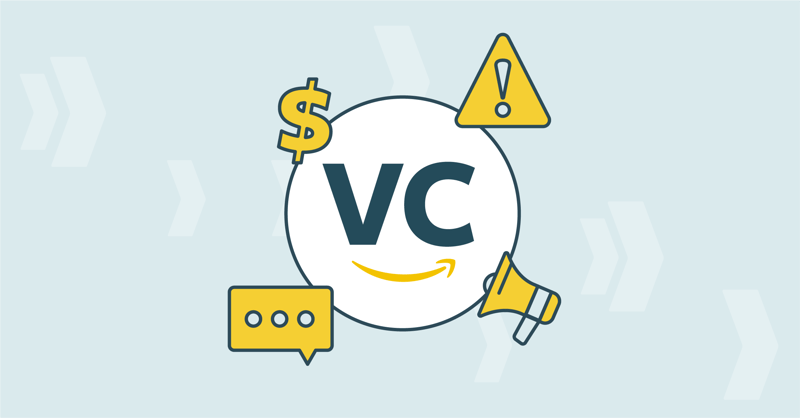
Amazon Vendor Central can be a great platform for sellers who want to eliminate hassle by selling directly to Amazon. Brands invited to the Vendor Central platform choose to sell 1P/Vendor Central for the promise of routine orders directly from Amazon and the perceived credibility of “Sold by Amazon” on their listings.
Vendor Central does have some downsides, however, namely a lack of control on pricing and very little guidance on the marketing front. This can lead to missed opportunities—and missed revenue. (If you’re curious, we break down the pros and cons of selling 1P vs. 3P more here.)
At SupplyKick, there are a few distinct issues that tend to pop up in our conversations with Vendor Central brands most. These issues include:
We break down five of the biggest problems Vendor Central brands typically face (you are not alone!) and offer solutions and best practices on where to go from here:
Supply chain, inflation, pandemic impact—now more than ever, protecting your margin is imperative. But with Vendor Central, Amazon is not accepting increases, so when you need to raise your product costs, Amazon refuses the request.
Switching to Amazon Seller Central, however, gives you better control over your pricing. And if you choose to work with a trusted third-party seller, you have the ability to work directly with that seller to increase costs based on the current macroeconomic environment.
On Vendor Central, Amazon decides if they want to adjust your prices, and they will sometimes even violate their own regulations. Unfortunately, Amazon is notorious for breaking MAP (minimum advertised price) policies if there is a chance to win the Buy Box, and overstock situations can cause involuntary adjustments, too.
If you submit retail pricing changes to Vendor Central, Amazon does not have to accept those changes. Amazon has 60 days to approve or decline your suggestion, and when time is of the essence, that can be too long to wait. Additionally, since Amazon submits requests for bulk purchase orders (POs) and wants to keep purchasing at a lower price, it’s unlikely that Amazon will approve your cost increases at all (as mentioned in the previous section). Amazon sends contract renewals yearly, and at the end of the day their focus is on improving their margins, not necessarily yours.
Switching to and selling via Seller Central can help control these issues. Whether it be for a specific ASIN or your entire product assortment, you’ll regain the control and price consistency you need to grow and stay competitive on the marketplace. It’s important to note, though, that whether you sell via Vendor Central or Seller Central, you’ll want to continue to diligently monitor your listings for price violations and unauthorized sellers.
Keep in mind: When you sell directly to Amazon or to multiple third-party sellers, you’re relinquishing control of your brand on the platform. Unless you sell yourself or have a strong relationship with a single 3P seller, it is very difficult to control who is selling your product at what price. Teaming up with a trusted single-seller or Amazon agency consultant can help ensure your MAP pricing strategy or MSRP is strictly enforced on the platform. They’ll work with you to maintain the best prices for your products, place consistent POs just like Amazon, and absorb other 3P fees—giving you peace of mind and the ability to focus on other key aspects of your business.
Confusing and excessive chargebacks on things you don't understand—like incorrect labeling of products, incorrect shrink wrap, or UPC/SKU not visible—are frustrating and common via Vendor Central. Amazon may also charge you for things out of your control, like missed carrier pickups. The goal of all sellers is to increase their Amazon sales, and these charges can slowly eat away at your margin.
If you switch to Seller Central, find a trusted Amazon seller and agency who doesn’t do chargebacks.
Vendor Central brands complain about a lack of control with their marketing and advertising strategies, as well as a lack of brand consistency across channels and ecommerce marketplaces. Amazon Vendor Central expects brands to know how to write optimized content and implement it themselves with little or no guidance on competitive search trends and best practices. With advertising, brands pay a "co-op" fee every month, but have very little (if any) visibility into where their spend is going. If you want to run your own PPC campaigns on Amazon, you have to do it yourself, again without any help from Amazon.
Creating compelling content, optimizing for SEO, and running profitable advertising campaigns are complicated but necessary components of a successful Amazon marketing strategy. For those wishing they had access to the marketing/ad insights and tools they need to cater to Amazon customer behaviors and increase sales—transitioning to Seller Central is key.
Furthermore, Vendor Central does not do any account management work for you, like managing cases, ensuring positive customer experiences (and reviews), and fixing suppressed listings. In order to manage Amazon properly, you need to have access to a team who has the time, resources, and expertise to deal with Amazon Vendor Central day-to-day—whether that be an internal team or external partner.
When Vendor Central brands run into problems, they will have to contact Amazon Seller Support—which can be time-consuming and difficult to manage on your own. On top of that, if your sales are below a certain Amazon-determined threshold, you will not have access to a Vendor Manager. This can make both large and small issues extremely difficult to deal with and get resolved quickly.
Having constant access to real people is important to maintaining your brand, and is also one of the hallmarks of working with a well-connected Amazon agency who has direct communication with Amazon reps and an entire team devoted to keeping up with case resolution.
If you sell through Vendor Central, it’s probably a tough call to make, but switching to Seller Central will likely be more profitable in the long run and be easier to manage—as long as you have the right approach and the right people and resources in place to make selling 3P/Seller Central sustainable and successful for your brand in the long term.
At SupplyKick, we help brands find efficiencies and overcome complexities that come with selling directly to Amazon—saving you loads of time (and many moments of frustration) while continuing to grow on the marketplace. Here’s how we team up with brands currently selling 1P/Vendor Central:
For additional reading, take a look at how we’ve helped brands like ciao! baby and Endangered Species Chocolate transition away from Amazon Retail/Vendor Central, and learn more below:
Regardless of which method you choose, SupplyKick helps you simplify your ecommerce selling experience and makes sure your brand is fully optimized for growth on Amazon and beyond. For help tackling any issues you may be experiencing on Vendor Central right now, reach out to our team.
Lorem ipsum dolor sit amet, consectetur adipiscing elit


Sign up to receive our newsletter for growth strategies, important updates, inventory and policy changes, and best practices.
These Stories on Brand Management
For press inquiries, please contact Molly Horstmann, mhorstmann@supplykick.com